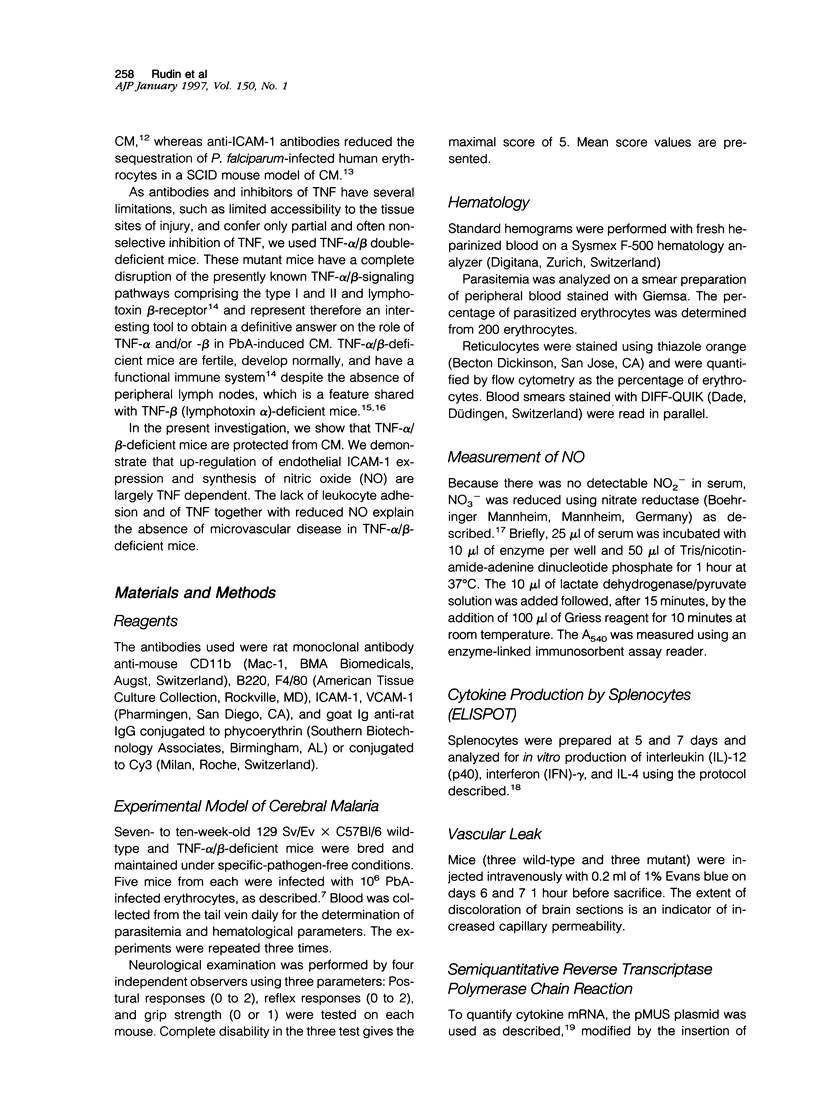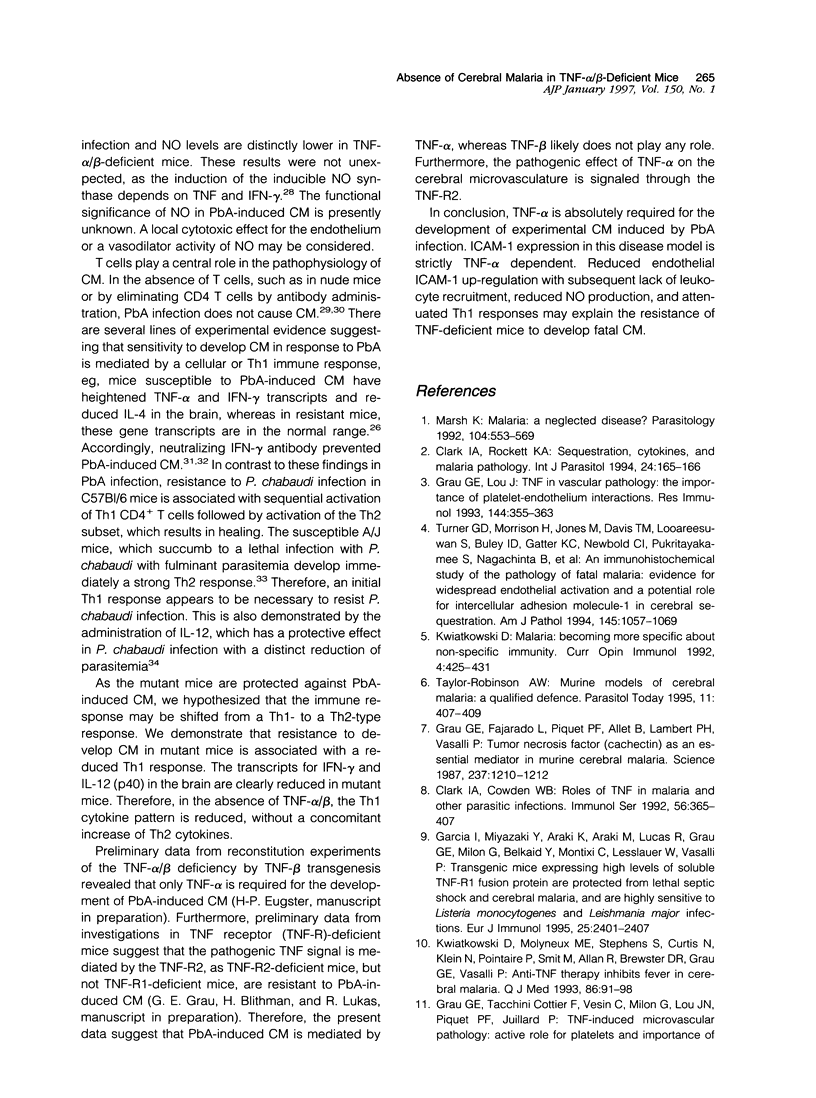Abstract
Tumor necrosis factor (TNF) induced by Plasmodium berghei ANKA (PbA) infection was suggested to play an important role in the development of cerebral malaria (CM). We asked whether TNF-alpha/beta double-deficient mice, which have a complete disruption of the TNF-signaling pathways, are protected from CM and what might be the possible mechanisms of protection. PbA infection induces fatal CM in wild-type mice, which die within 5 to 8 days with severe neurological signs. In contrast, TNF-alpha/beta-deficient mice are completely resistant to PbA-induced CM. As PbA-induced up-regulation of endothelial intercellular adhesion molecule (ICAM)-1 expression as well as the systemic release of nitric oxide is found only in wild-type mice, TNF is apparently central for the recruitment of mononuclear cells and microvascular damage. Mononuclear cell adhesion to the endothelium, vascular leak and, perivascular hemorrhage are found only in the brain of wild-type mice. By contrast, the development of parasitemia and anemia is independent of TNF. Resistance to CM in TNF-alpha/beta-deficient mice is associated with reduced interferon-gamma and interleukin-12 expression in the brain, in the absence of increased T helper type 2 cytokines. In conclusion, TNF apparently is required for PbA-induced endothelial ICAM-1 up-regulation and subsequent microvascular pathology resulting in fatal CM. In the absence of TNF, ICAM-1 and nitric oxide up-regulation are reduced, and PbA infection fails to cause fatal CM.
Full text
PDF









Images in this article
Selected References
These references are in PubMed. This may not be the complete list of references from this article.
- Banks T. A., Rouse B. T., Kerley M. K., Blair P. J., Godfrey V. L., Kuklin N. A., Bouley D. M., Thomas J., Kanangat S., Mucenski M. L. Lymphotoxin-alpha-deficient mice. Effects on secondary lymphoid organ development and humoral immune responsiveness. J Immunol. 1995 Aug 15;155(4):1685–1693. [PubMed] [Google Scholar]
- Bredt D. S., Snyder S. H. Nitric oxide: a physiologic messenger molecule. Annu Rev Biochem. 1994;63:175–195. doi: 10.1146/annurev.bi.63.070194.001135. [DOI] [PubMed] [Google Scholar]
- Car B. D., Eng V. M., Schnyder B., LeHir M., Shakhov A. N., Woerly G., Huang S., Aguet M., Anderson T. D., Ryffel B. Role of interferon-gamma in interleukin 12-induced pathology in mice. Am J Pathol. 1995 Dec;147(6):1693–1707. [PMC free article] [PubMed] [Google Scholar]
- Clark I. A., Cowden W. B. Roles of TNF in malaria and other parasitic infections. Immunol Ser. 1992;56:365–407. [PubMed] [Google Scholar]
- Clark I. A., Rockett K. A. Sequestration, cytokines, and malaria pathology. Int J Parasitol. 1994 Apr;24(2):165–166. doi: 10.1016/0020-7519(94)90022-1. [DOI] [PubMed] [Google Scholar]
- De Togni P., Goellner J., Ruddle N. H., Streeter P. R., Fick A., Mariathasan S., Smith S. C., Carlson R., Shornick L. P., Strauss-Schoenberger J. Abnormal development of peripheral lymphoid organs in mice deficient in lymphotoxin. Science. 1994 Apr 29;264(5159):703–707. doi: 10.1126/science.8171322. [DOI] [PubMed] [Google Scholar]
- Eugster H. P., Muller M., Karrer U., Car B. D., Schnyder B., Eng V. M., Woerly G., Le Hir M., di Padova F., Aguet M. Multiple immune abnormalities in tumor necrosis factor and lymphotoxin-alpha double-deficient mice. Int Immunol. 1996 Jan;8(1):23–36. doi: 10.1093/intimm/8.1.23. [DOI] [PubMed] [Google Scholar]
- Garcia I., Miyazaki Y., Araki K., Araki M., Lucas R., Grau G. E., Milon G., Belkaid Y., Montixi C., Lesslauer W. Transgenic mice expressing high levels of soluble TNF-R1 fusion protein are protected from lethal septic shock and cerebral malaria, and are highly sensitive to Listeria monocytogenes and Leishmania major infections. Eur J Immunol. 1995 Aug;25(8):2401–2407. doi: 10.1002/eji.1830250841. [DOI] [PubMed] [Google Scholar]
- Grau G. E., Fajardo L. F., Piguet P. F., Allet B., Lambert P. H., Vassalli P. Tumor necrosis factor (cachectin) as an essential mediator in murine cerebral malaria. Science. 1987 Sep 4;237(4819):1210–1212. doi: 10.1126/science.3306918. [DOI] [PubMed] [Google Scholar]
- Grau G. E., Heremans H., Piguet P. F., Pointaire P., Lambert P. H., Billiau A., Vassalli P. Monoclonal antibody against interferon gamma can prevent experimental cerebral malaria and its associated overproduction of tumor necrosis factor. Proc Natl Acad Sci U S A. 1989 Jul;86(14):5572–5574. doi: 10.1073/pnas.86.14.5572. [DOI] [PMC free article] [PubMed] [Google Scholar]
- Grau G. E., Lou J. TNF in vascular pathology: the importance of platelet-endothelium interactions. Res Immunol. 1993 Jun;144(5):355–363. doi: 10.1016/s0923-2494(93)80080-i. [DOI] [PubMed] [Google Scholar]
- Grau G. E., Piguet P. F., Engers H. D., Louis J. A., Vassalli P., Lambert P. H. L3T4+ T lymphocytes play a major role in the pathogenesis of murine cerebral malaria. J Immunol. 1986 Oct 1;137(7):2348–2354. [PubMed] [Google Scholar]
- Grau G. E., Pointaire P., Piguet P. F., Vesin C., Rosen H., Stamenkovic I., Takei F., Vassalli P. Late administration of monoclonal antibody to leukocyte function-antigen 1 abrogates incipient murine cerebral malaria. Eur J Immunol. 1991 Sep;21(9):2265–2267. doi: 10.1002/eji.1830210939. [DOI] [PubMed] [Google Scholar]
- Hutchings P. R., Cambridge G., Tite J. P., Meager T., Cooke A. The detection and enumeration of cytokine-secreting cells in mice and man and the clinical application of these assays. J Immunol Methods. 1989 Jun 2;120(1):1–8. doi: 10.1016/0022-1759(89)90281-0. [DOI] [PubMed] [Google Scholar]
- Jacobs P., Radzioch D., Stevenson M. M. Nitric oxide expression in the spleen, but not in the liver, correlates with resistance to blood-stage malaria in mice. J Immunol. 1995 Dec 1;155(11):5306–5313. [PubMed] [Google Scholar]
- Kwiatkowski D. Malaria: becoming more specific about non-specific immunity. Curr Opin Immunol. 1992 Aug;4(4):425–431. doi: 10.1016/s0952-7915(06)80034-8. [DOI] [PubMed] [Google Scholar]
- Kwiatkowski D., Molyneux M. E., Stephens S., Curtis N., Klein N., Pointaire P., Smit M., Allan R., Brewster D. R., Grau G. E. Anti-TNF therapy inhibits fever in cerebral malaria. Q J Med. 1993 Feb;86(2):91–98. [PubMed] [Google Scholar]
- Lackritz E. M., Campbell C. C., Ruebush T. K., 2nd, Hightower A. W., Wakube W., Steketee R. W., Were J. B. Effect of blood transfusion on survival among children in a Kenyan hospital. Lancet. 1992 Aug 29;340(8818):524–528. doi: 10.1016/0140-6736(92)91719-o. [DOI] [PubMed] [Google Scholar]
- Miller L. H., Good M. F., Milon G. Malaria pathogenesis. Science. 1994 Jun 24;264(5167):1878–1883. doi: 10.1126/science.8009217. [DOI] [PubMed] [Google Scholar]
- Phillips R. E., Pasvol G. Anaemia of Plasmodium falciparum malaria. Baillieres Clin Haematol. 1992 Apr;5(2):315–330. doi: 10.1016/s0950-3536(11)80022-3. [DOI] [PubMed] [Google Scholar]
- Prada J., Kremsner P. G. Enhanced production of reactive nitrogen intermediates in human and murine malaria. Parasitol Today. 1995 Nov;11(11):409–410. doi: 10.1016/0169-4758(95)80019-0. [DOI] [PubMed] [Google Scholar]
- Prada J., Prager C., Neifer S., Bienzle U., Kremsner P. G. Production of interleukin-6 by human and murine mononuclear leukocytes stimulated with Plasmodium antigens is enhanced by pentoxifylline, and tumor necrosis factor secretion is reduced. Infect Immun. 1993 Jun;61(6):2737–2740. doi: 10.1128/iai.61.6.2737-2740.1993. [DOI] [PMC free article] [PubMed] [Google Scholar]
- Rockett K. A., Awburn M. M., Aggarwal B. B., Cowden W. B., Clark I. A. In vivo induction of nitrite and nitrate by tumor necrosis factor, lymphotoxin, and interleukin-1: possible roles in malaria. Infect Immun. 1992 Sep;60(9):3725–3730. doi: 10.1128/iai.60.9.3725-3730.1992. [DOI] [PMC free article] [PubMed] [Google Scholar]
- Rockett K. A., Awburn M. M., Rockett E. J., Cowden W. B., Clark I. A. Possible role of nitric oxide in malarial immunosuppression. Parasite Immunol. 1994 May;16(5):243–249. doi: 10.1111/j.1365-3024.1994.tb00346.x. [DOI] [PubMed] [Google Scholar]
- Stevenson M. M., Tam M. F. Differential induction of helper T cell subsets during blood-stage Plasmodium chabaudi AS infection in resistant and susceptible mice. Clin Exp Immunol. 1993 Apr;92(1):77–83. doi: 10.1111/j.1365-2249.1993.tb05951.x. [DOI] [PMC free article] [PubMed] [Google Scholar]
- Stevenson M. M., Tam M. F., Wolf S. F., Sher A. IL-12-induced protection against blood-stage Plasmodium chabaudi AS requires IFN-gamma and TNF-alpha and occurs via a nitric oxide-dependent mechanism. J Immunol. 1995 Sep 1;155(5):2545–2556. [PubMed] [Google Scholar]
- Taylor-Robinson A. W. Murine models of cerebral malaria: a qualified defence. Parasitol Today. 1995 Nov;11(11):407–409. doi: 10.1016/0169-4758(95)80018-2. [DOI] [PubMed] [Google Scholar]
- Turner G. D., Morrison H., Jones M., Davis T. M., Looareesuwan S., Buley I. D., Gatter K. C., Newbold C. I., Pukritayakamee S., Nagachinta B. An immunohistochemical study of the pathology of fatal malaria. Evidence for widespread endothelial activation and a potential role for intercellular adhesion molecule-1 in cerebral sequestration. Am J Pathol. 1994 Nov;145(5):1057–1069. [PMC free article] [PubMed] [Google Scholar]
- Willimann K., Matile H., Weiss N. A., Imhof B. A. In vivo sequestration of Plasmodium falciparum-infected human erythrocytes: a severe combined immunodeficiency mouse model for cerebral malaria. J Exp Med. 1995 Sep 1;182(3):643–653. doi: 10.1084/jem.182.3.643. [DOI] [PMC free article] [PubMed] [Google Scholar]
- de Kossodo S., Grau G. E. Profiles of cytokine production in relation with susceptibility to cerebral malaria. J Immunol. 1993 Nov 1;151(9):4811–4820. [PubMed] [Google Scholar]
- de Kossodo S., Grau G. E. Role of cytokines and adhesion molecules in malaria immunopathology. Stem Cells. 1993 Jan;11(1):41–48. doi: 10.1002/stem.5530110108. [DOI] [PubMed] [Google Scholar]






